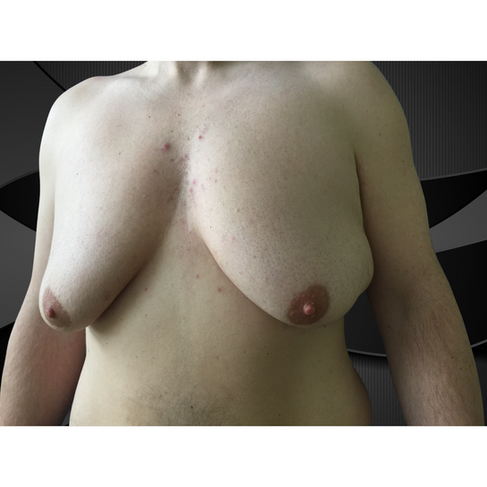Understanding Gynecomastia Grades – Symptoms and Surgical Solutions
- Wojciech Berendt

- May 18
- 4 min read
Have you noticed that your chest appears enlarged or more developed than you expected? Do you feel uncomfortable because of it? You might be experiencing gynecomastia — a common condition that affects millions of men worldwide.
Gynecomastia can occur at any age — from adolescence to adulthood. It is characterized by the enlargement of firm, dense glandular breast tissue, often combined with fatty tissue, leading to a visibly enlarged chest. Importantly, this type of tissue does not respond to diet or exercise. That’s why many men struggling with gynecomastia are unable to restore their natural chest contour on their own. Abnormal development of glandular tissue can significantly alter your physique and negatively impact self-confidence.
In more advanced cases, the excess tissue may cause sagging skin, further affecting appearance and comfort.

Grade 1 – Mild Enlargement Without Sagging Skin
In the mildest cases of gynecomastia, the chest appears nearly natural, without visible excess skin or sagging. This involves a slight enlargement of the glandular tissue, which may cause the chest to look slightly fuller, but the changes are usually very subtle and often hard to notice. Although some physicians attempt to estimate the amount of tissue in grams, accurately assessing this before surgery is challenging. Therefore, the degree of gynecomastia is primarily evaluated based on appearance and clinical symptoms.
Surgical Treatment:
Depending on the nature of the gynecomastia — whether fatty tissue, glandular tissue, or a combination is predominant — the treatment method is tailored individually to each patient.
In cases of fat-dominant gynecomastia, liposuction is the primary treatment method, effectively removing excess fat and precisely reshaping the chest contour.
When glandular tissue predominates, surgical excision is necessary to fully correct the deformity. For mixed-type gynecomastia, a combination of both techniques is most commonly used, providing optimal aesthetic results. These procedures are generally minimally invasive, and the recovery period is usually short and well-tolerated by most patients.
Grade 2 Gynecomastia – Moderate Enlargement With Little or No Skin Sagging
In Grade 2 gynecomastia, the changes in chest appearance become noticeably more visible compared to Grade 1. The chest takes on a rounder and fuller shape, which can often be visible even through clothing. Despite the increased volume, the skin generally remains firm and elastic.
Surgeons often divide this grade into two subcategories:
Grade 2A: Moderate enlargement without noticeable excess skin
Grade 2B: Moderate enlargement with slight excess skin, though not enough to cause significant sagging or deformity
Medical Treatment
Treatment for Grade 2 gynecomastia typically involves a combination of liposuction and surgical excision of glandular tissue. If mild skin laxity is present (Grade 2B), gentle skin tightening or reshaping may also be performed.
This approach provides a significant improvement in chest contour and helps restore patient confidence and comfort, with minimal downtime and natural-looking results.
Grade 3 Gynecomastia – Significant Enlargement with Mild Skin Sagging
In Grade 3 gynecomastia, the changes become clearly more advanced. The amount of enlarged glandular breast tissue is substantial, often exceeding 500 grams of combined fatty and glandular tissue. At this stage, visible—but still mild—skin sagging begins to appear.
The weight of the enlarged tissue causes the skin to start sagging slightly, which alters the natural contour of the chest. Although the skin drooping is not yet severe, it is noticeable enough to affect both the aesthetic appearance and the patient’s comfort.
Surgical Treatment
At this stage, a more comprehensive surgical approach is necessary. This typically combines liposuction with excision of the glandular breast tissue, often accompanied by skin correction to remove excess skin and prevent further sagging.
The procedure may require a longer recovery period but provides significant visual and comfort improvements for the patient.
Grade 4 Gynecomastia – Advanced Enlargement with Pronounced Skin Sagging
Grade 4 gynecomastia represents the most advanced form of the condition. It is characterized by significant enlargement of the breast tissue and pronounced, visible skin sagging. At this stage, the chest may take on a shape that deviates considerably from the typical male contour due to stretched skin and enlarged areolas, which often begin to point downward. These changes have a profound impact on the patient’s appearance and comfort, causing not only aesthetic but also psychological distress.
Grade 4 requires comprehensive surgical treatment that involves removing excess tissue as well as excess skin to restore a natural, masculine chest contour.
Surgical Treatment
Treatment at this stage is an advanced procedure that includes removal of a large amount of fatty and glandular tissue, along with significant reshaping of the skin and nipples. It often requires incisions that allow for removal of excess skin and nipple repositioning to regain proper proportion and chest appearance. Recovery tends to be longer, but the results are the most satisfying and long-lasting.
Gynecomastia is a problem that can be effectively treated. With appropriately selected surgical methods, it is possible to restore a masculine chest contour and regain self-confidence. If you notice symptoms of gynecomastia and would like to consult a specialist, feel free to contact me. I approach every case individually, offering comprehensive diagnostics and effective, aesthetic treatment.
























Comments